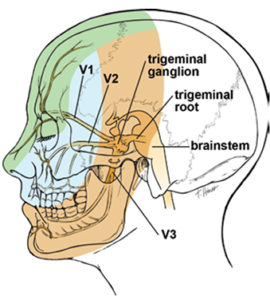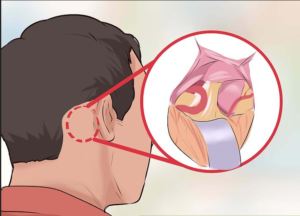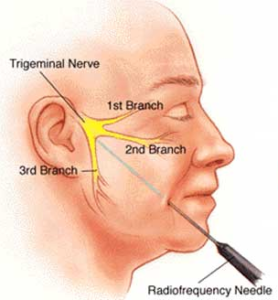Trigeminal neuralgia or tic douloureux is the condition where patients experience severe pain along one or more divisions of the trigeminal nerve (V nerve). This is not an uncommon disorder but patients often present after multiple consultations for dental disorders or herpetic neuralgia or even migraine. It is therefore important to identify and treat this disease.
Anatomy
The trigeminal nerve is a mixed sensory motor nerve that exits the brain in the base of the middle cranial fossa, under the temporal lobe and serves two main functions. The motor supply is the muscles of mastication and the sensory supply is to the entire face and anterior 1/2 to 2/3 of the scalp. This sensory supply is done via 3 branches, the ophthalmic (V1), maxillary (V2) and mandibular (V3) divisions. The nerve exits the upper part of the pons and runs in the space of the prepontine cistern to then form the Gasserian ganglion that further divides into the 3 divisions, as mentioned above.
Characteristics of TN
Trigeminal Neuralgia is characterized by severe, sharp lancinating pain in one or more of the divisions of the nerve. This pain maybe paroxysmal – occurring suddenly without provocation or during any activity such as brushing or chewing or even on exposure to a breeze to the face. In some patients the pain is continuous and debilitating.
Most of patients have such severe pain that it interferes with most activities of daily living and often patients develop reluctance to perform any activity that can precipitate the attack.
The most common cause of idiopathic trigeminal neuralgia is a ‘neurovascular conflict’. The intracranial portion of the trigeminal nerve lies in a space called the pre-pontine cistern. The superior cerebellar artery normally runs close to but not touching the nerve. Most patients of trigeminal neuralgia have an anomaly where the artery touches this nerve and the constant pulsation causes nerve damage in the form of demyelination – not different from damage to the insulation on an electric wire if it constantly rubs against a wall. This nerve damage causes hypersensitivity of the nerve and causes the pain. The conflict maybe most commonly due to the artery mentioned above but often other vascular structures such as a vein or other arteries may cause the same. While this is the commonest cause, other causes include tumors in the area of the trigeminal nerve and rarely Multiple Sclerosis.
Evaluation is by a detailed history and examination specifically regarding a trigger point or the starting point of the pain in the face. This is important for deciding the treatment of the patient. A high resolution MRI of the brain with cisternography (CISS-3D/FIESTA sequences) in coronal, axial and sagittal planes is required for 2 reasons – to rule out a tumor (meningioma, epidermoid), or aneurysm, or multiple sclerosis; and to look for the vascular loop touching the nerve.
Treatment
The mainstay of treatment of trigeminal neuralgia is Carbamazepine (CBZ). This antiepileptic is the first line of treatment and a significant number of patients have substantial relief. Often Baclofen is added on as an adjunct treatment if higher doses of CBZ are not tolerated due to side effects. Other anti-epileptics such as oxcarbazepine, phenytoin, gabapentin, clonazepam have shown some benefit. Most patients will attain some form of remission with one or more of these medications. In time though a proportion of patients will fail medical therapy.
For patients who have either no relief with either initial medical therapy or relapse following a period of remission, surgical methods of pain relief are required. These are of 3 main types – percutaneous injections, microvascular decompression, gamma knife radiosurgery.

The treatment of choice in patients who are fit for surgery and have no medical contraindications is microvascular decompression. This involves a small opening in the skull and separating the artery or vein from the nerve. The pain relief is almost instantaneous and has the longest long term pain-free interval of all surgical methods.

For patients who are not fit for surgery or choose a less invasive option, percutaneous techniques involve placing a needle into the Gasserian ganglion and permanently effecting the nerve. This is done either via radiofrequency ablation or burning or via injection of alcohol
. This reduces the sensitivity of the trigeminal nerve and has a good reduction in pain. This however is not a durable solution and a subset of patients may have recurrent pain after an average of 2 years. These procedures also may cause some amount of numbness over the face due to direct intervention on the nerve fibres. The injection is also not an option for patients who have trigger zones in the upper part of the face since the procedure may cause lack of sensation on the cornea of the eye, leaving it vulnerable to injury.
The last mode of treatment of trigeminal neuralgia is via gamma knife radiosurgery. The gamma knife is a specialized radiation delivery unit that can focus high doses of radiation on a small target with minimal damage to surrounding normal areas. It has been successfully used to treat trigeminal neuralgia by targeting the part of the trigeminal nerve within the skull. Patients usually have relief in a few days with a reasonable durability of remission.
The important part of the treatment of trigeminal neuralgia is early recognition of the disorder which can mimic multiple conditions such as cluster headaches, migraines, sinusitis, dental issues, to name a few. Early imaging studies to rule out other pathological conditions in the brain followed by treatment with CBZ is the first choice. The availability of safe and effective surgical options warrant a low threshold for considering them in patients who have failed medical treatment.